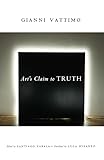Art's Claim to Truth / Gianni Vattimo; ed. by Santiago Zabala.
Material type: TextSeries: Columbia Themes in Philosophy, Social Criticism, and the ArtsPublisher: New York, NY : Columbia University Press, [2008]Copyright date: ©2008Description: 1 online resource (216 p.)Content type:
TextSeries: Columbia Themes in Philosophy, Social Criticism, and the ArtsPublisher: New York, NY : Columbia University Press, [2008]Copyright date: ©2008Description: 1 online resource (216 p.)Content type: - 9780231138512
- 9780231515665
- 111/.85 22
- BH39 .V3413 2008
- online - DeGruyter
- Issued also in print.
| Item type | Current library | Call number | URL | Status | Notes | Barcode | |
|---|---|---|---|---|---|---|---|
 eBook
eBook
|
Biblioteca "Angelicum" Pont. Univ. S.Tommaso d'Aquino Nuvola online | online - DeGruyter (Browse shelf(Opens below)) | Online access | Not for loan (Accesso limitato) | Accesso per gli utenti autorizzati / Access for authorized users | (dgr)9780231515665 |
Browsing Biblioteca "Angelicum" Pont. Univ. S.Tommaso d'Aquino shelves, Shelving location: Nuvola online Close shelf browser (Hides shelf browser)

|

|

|

|

|

|

|
||
| online - DeGruyter For Kin or Country : Xenophobia, Nationalism, and War / | online - DeGruyter Teens in Crisis : How the Industry Serving Struggling Teens Helps and Hurts Our Kids / | online - DeGruyter Literature, Life, and Modernity / | online - DeGruyter Art's Claim to Truth / | online - DeGruyter Modernity and the Text : Revisions of German Modernism / | online - DeGruyter The Undiscovered Dewey : Religion, Morality, and the Ethos of Democracy / | online - DeGruyter Hear Us Out : Conversations with Gay Novelists / |
Frontmatter -- Contents -- Acknowledgments -- Introduction: The Hermeneutic Consequence of Art's Ontological Bearing Santiago Zabala -- Part 1. aesthetics -- 1. Beauty and Being in Ancient Aesthetics -- 2. Toward an Ontological Aesthetics -- 3. The Ontological Vocation of Twentieth- Century Poetics -- 4. Art, Feeling, and Originality in Heidegger's Aesthetics -- Part II. Hermeneutics -- 5. Pareyson: From Aesthetics to Ontology -- 6. From Phenomenological Aesthetics to Ontology of Art -- 7. Critical Methods and Hermeneutic Philosophy -- Part III. Truth -- 8. Aesthetics and Hermeneutics -- 9. Aesthetics and Hermeneutics in Hans- Georg Gadamer -- 10. The Work of Art as the Setting to Work of Truth -- 11. The Truth That Hurt -- Notes -- Index
restricted access online access with authorization star
http://purl.org/coar/access_right/c_16ec
First collected in Italy in 1985, Art's Claim to Truth is considered by many philosophers to be one of Gianni Vattimo's most important works. Newly revised for English readers, the book begins with a challenge to Plato, Aristotle, Kant, and Hegel, who viewed art as a metaphysical aspect of reality rather than a futuristic anticipation of it. Following Martin Heidegger's interpretation of the history of philosophy, Vattimo outlines the existential ontological conditions of aesthetics, paying particular attention to the works of Kandinsky, which reaffirm the ontological implications of art.Vattimo then builds on Hans-Georg Gadamer's theory of aesthetics and provides an alternative to a rationalistic-positivistic criticism of art. This is the heart of Vattimo's argument, and with it he demonstrates how hermeneutical philosophy reaffirms art's ontological status and makes clear the importance of hermeneutics for aesthetic studies. In the book's final section, Vattimo articulates the consequences of reclaiming the ontological status of aesthetics without its metaphysical implications, holding Aristotle's concept of beauty responsible for the dissolution of metaphysics itself. In its direct engagement with the works of Gadamer, Heidegger, and Luigi Pareyson, Art's Claim to Truth offers a better understanding of the work of Vattimo and a deeper knowledge of ontology, hermeneutics, and the philosophical examination of truth.
Issued also in print.
Mode of access: Internet via World Wide Web.
In English.
Description based on online resource; title from PDF title page (publisher's Web site, viewed 02. Mrz 2022)


